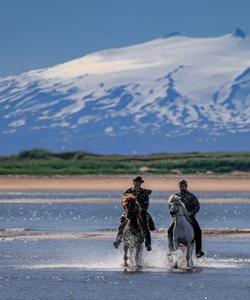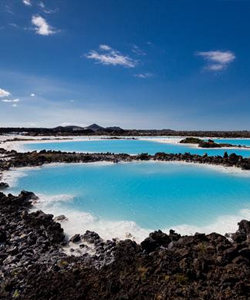
Climate
Icelandic climate – basics

Iceland lies just south of the Arctic Circle. It's climate is considered subpolar oceanic implying cool, wet and most of all short summers. Average temperatures in the time between May and October lie between 10-14°C
The climate during winter time is surprisingly mild taking into account Iceland's northerly latitude. This is due to the levelling effect of the surrounding North Atlantic ocean. Average temperatures in winter hover around -3°C (27°F). The average annual temperature in Reykjavik, the capital, is 5°C (41°F).
“Average“ temperatures are only very poor indicators of what the actual temperatures are like, though. For example, one sunny summer day 1939 in Teigarhorn, a village in the East of the island, the thermometer went up to an unheard 30°C (68°F)!
The very other extreme: the lowest ever recorded temperature in Iceland was -37°C (-35°F) in a place called Grimstaðir in the North-East (Grimstaðir: "grim place". Well...).
Talking about Icelandic climate and more so its temperatures it's important to take into account that a number on the thermometer doesn't always correspond to what you feel. 17°C in the summer with the intense sun can feel very hot in Iceland - a lot hotter in fact than it would back in your home country. That's to say you will find yourself in T-Shirt at temperatures where back home you might close the zipper of your jacket.

Let's talk about the weather

The southern coast of Iceland generally has the warmer but also wetter and windier weather. Clouds arriving from the South get stuck on the mountain tops where they unload their wet burden before even reaching the North. Sometimes, for justice's sake, when the winds change their direction it's the other way around, though.
The North and the interior are the countries driest zones. Most of all the interior is arid and barren - in it's own special beauty. Being the farthest away from the levelling effects of the ocean it also has the lowest temperatures, at least in winter. In the summer on the other hand, day interior temperatures can rise up to a heart lifting 20°C.
In the winter snow is more common in the North and the interior than in the South. Winter's also the time of the most ferocious winds.
Wind and rain you should be prepared for when coming to Iceland, though neither of them uses to last very long. A popular Icelandic saying is: If you don't like the weather just wait five minutes. Besides, weather is a question of the right cloths. And the right attitude :-)
The current weather forecast for Iceland can be found on www.vedur.is. But be aware that the information given there is more a „global idea“, the actual facts in most of the cases have nothing to do with it.

Best travelling time
So when should you come here ?

It depends, obviously, in this case on what you're out after. Iceland's worth a visit year round. Summer's the time to be out and about in the countries unspoiled and stunning nature. Iceland's a hiker's paradise with hundreds of marked trails all over the place. During the summer months, although there is no "real" midnight sun (that's to say the sun always sinks below the horizon for a short while) it will never get completely dark.
But also autumn and winter hold its beauty. Those are the times to witness the magical show of the Northern Lights playing across the sky (see also our section on the „Northern Lights“ [internal link].
Cross country skiing is a popular activity.
That the country dwells in complete darkness during the winter is a myth. Even in the darkest months (December & January) there are at least four hours of - not bright sunlight - but still light, with the low sun turning the days into never ending sunsets (or dawns), the sky exploding in yellow, orange and red.